At long last it’s coming to the U.S. as an option to the already available VFR1200F with standard transmission. The DCT-equipped bike should be available through dealers around late June or the first week of July, according to Honda’s Assistant Manager Motorcycle Press, Jon Seidel.
The most advanced – or controversial – innovation on this upscale bike is its compact transmission that uses two clutches to shift gears, with the ability to do so automatically. As the first of its kind ever put in a motorcycle, it works like those found on F1 race cars, as well as street-going supercars, and even sports cars from the likes of Mitsubishi and VW.
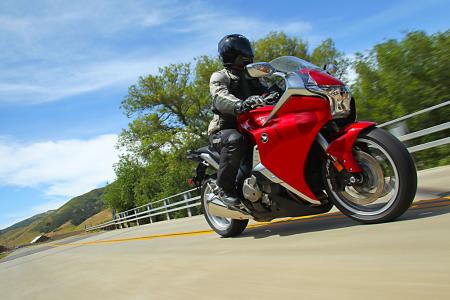 The VFR1200F’s riding position is functional and designed to travel in purposeful style. |
In order to adopt this innovation from the car guys’ favorite rides, new technological ground had to be plowed in the country that also once gave the world the Bonsai tree.
For its latest feat of mechanical miniaturization, Honda chose the new 1,237cc VFR – a 613-lb touring-capable sportbike which is neither a full-on supersports machine nor a luxury sport-tourer.
Some pundits have wondered what Honda’s people were thinking by developing an automotive-style race transmission that is not used in MotoGP or any other form of motorcycle competition. And instead of introducing the purported performance enhancer in a CBR, they put it in a bike that is more likely competition for a BMW K1300S than anything else.
In fact, the DCT is more of a luxury feature, providing an electronically shifted manual transmission that can also work in fully automatic mode, and is not something meant for quicker lap times.
According to Seidel, Honda spent five years engineering and honing the new VFR prior to production, instead of the usual three.
“This is a motorcycle that’s very special obviously for us at Honda, for our dealers, for R&D, just for everybody,” Seidel said.
The V-Four was “Mr. Honda’s favorite engine configuration,” Seidel said, and the new VFR was chosen to introduce DCT because since the 1982 VF750S Sabre, Honda’s V-Fours have become a platform to introduce – and take chances – on new technology.
“’Success is 99% failure,’” Seidel said, quoting Mr. Honda, who passed away in 1991, and is considered a maverick and visionary. (See our Honda history here.) “Through the history of Honda Motor Company,” added Seidel, “we’ve always been willing to change, to take a chance to kind of try to go to that new environment, that new frontier.”
 This 45-year-old pilot is directly within Honda's target demographic for the 2010 VFR1200F, and he wished he had a week to play on it instead of only a day. |
Honda anticipates target buyers will be predominantly experienced male riders around 45-years-old, Seidel said. They may be ex-racers or sport riders – such as the VFR1200’s project leader Yosuke Hasegawa – but their expectations will have shifted upwardly, along with their net worth.
A fleet of high-end chargers is ready to go.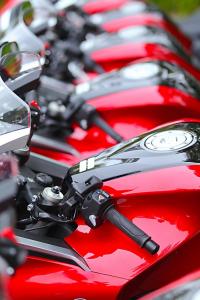
While the median buyer just squeaks into the Gen-X category, Seidel confirmed an observation recently made by Piaggio’s CEO that manufacturers are yet explicitly catering to those born from just after World War II through 1964.
“For sure, riders have changed. They’re maturing,” Seidel said, “Without a doubt, the Baby Boomers are still driving the market at this point.”
"Honda anticipates target buyers will be predominantly experienced male riders around 45-years-old."
A lot of these potential customers have already experienced “very exciting cars,” Seidel said, and they want flexible, high-quality toys festooned with cutting-edge engineering that deliver legitimate wow-factor.
“They want a lot of fun, they want to go fast, but it’s about acceleration, it’s about torque, it’s not just about excessive speed,” Seidel said. They are “interested in latest technology, open minded, and the real key feature here, and especially for the DCT, is that they are early adopters.”
Impressions
From the CPUs controlling the throttle-by-wire, to linked ABS, to the powertrain control module managing the engine and transmission, the VFR has failsafe redundancies built in to serve up a Buck Rogers experience that even Peewee Herman could not screw up.
To provide a feel for it, we were taken on a 115-mile loop that included freeways, rolling hills, sweepers, and a few kinks in the road. As a reference point, standard transmission VFR1200Fs were also ridden and swapped during the ride.
The penalty for DCT is a modest 22 lbs and $1,500 extra over the standard-clutch model. Honda’s engineers took pains to make its weight distribution, front-to-rear, and right-to-left so similar that the DCT-equipped bike essentially handles the same as one without DCT.
Therefore, everything else we’ve already written about the VFR1200F when we pitted it against the BMW K1300S applies to the DCT bike, albeit it shifts differently.
Automatic Mode
This is no constant-velocity transmission as found in the Aprilia Mana, but a far more sophisticated gear changer, with the watchword being, “seamless.”
Once the engine is started, the right thumb triggers the transmission out of neutral, and selects Drive (D) mode within the automatic transmission function (AT). If you hit the switch again, it goes to the Sport (S) mode of the automatic function.
Drive mode ought to be re-named “docile.” It wants to maximize fuel economy, and given this bike makes around 80 ft-lbs torque at 4,000 rpm, it will shift toward sixth gear ASAP and is reluctant to downshift when decelerating.
On the highway, if you twist the throttle to its stop, the transmission will drop two gears to fourth, which is what you’d also experience doing the same in Sport mode.
Aside from this, if you want to make haste, forget D, and go for S.
The S mode is as aggressive as D is tame. While accelerating, shift points are noticeably higher on the tachometer. If you pin it for a dragstrip run, it will shift a few hundred rpm below its 10,200-rpm redline indicated on the tachometer.
In either D or S, upshifts are perfect. You hear the revs drop, and under light load you might hear the gear click in, but in any case, it’s like superman did it at light speed.
Despite its modest 4.9-gallon fuel capacity, this bike is ready to eat up the miles.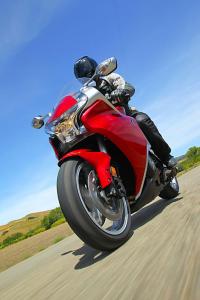
On the highway in S mode, the transmission will kick down a lot sooner than in D mode, as it will on basic deceleration.
Since its PCM is more in touch with the powertrain’s working parts than a human mind can be, downshifts are accompanied in either D or S by a barely perceptible throttle blip. This “blip” is precise, as the computer knows what rpm the transmission will hit in the next lower gear, so the revs are adjusted accordingly and there’s no lurching.
It is initially unnerving when not given control of the gear selection when entering corners, but this is something that could be gotten used to. Switching to manual mode puts control back in a rider’s hands.
Honda says the PCM’s shift points were programmed after dataloggers read input from experienced test riders in Japan, then they crunched the info through advanced algorithms.
What’s next, artificial intelligence that will learn and custom tailor shift points for an individual owner’s preference? When asked this question, Jon Seidel just laughed.
Overall, the AT mode works as advertised. It could be an especial benefit for those who want to forget about shifting on an otherwise capable sportbike, for some with handicaps, and for anyone who doesn’t want to deal with a clutch in traffic.
Manual Mode
The gear changers on the left switch housing were being called “paddle shifters” as they are for DCT cars that really do have steering wheel-mounted paddles. Actually, the bike’s shifters are sort of paddles, but more like a couple of switches operated by the left index finger and thumb.
At any time, whether standing still or on-the-fly, if you want out of automatic mode, your right index finger can pull a trigger that’s much like a flash-to-pass switch, albeit mounted on the right side.
Or, if you press the manual upshift or downshift trigger, the PCM assumes you meant to do that, and the bike instantly switches to MT mode. It will not shift out of the gear you selected unless you again upshift or downshift – or if you trigger the right side auto shift mode selector, or the right side AT selector.
Assuming you wanted to be in manual shift mode, and stay there, this tranny will put your previous best speedshift on a traditional bike to shame.
It is very odd, too, because you can pin this bike WFO and select either an upshift or downshift and it will bang that gear without any protest from the chassis. In other words, say you are rolling at 55 mph, and while maxing the throttle, you wanted to successively downshift instead of upshift like normal. The bike would let you do that.
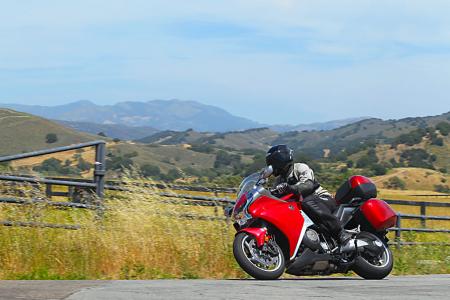 With bags or not, this is a sportbike meant to also tour. Most full face helmets will fit in the larger left-side saddlebag. |
Engine braking does still exist, so if you do something ham-fisted like drop it in first gear at 60 mph – which is near redline in that gear for this machine – you can expect some protest or sliding at the rear wheel.
The DCT does not have a slipper clutch, and in most cases doesn’t need one. In MT mode as well, the PCM’s precise throttle blips ordinarily keep you out of trouble.
Nor will the PCM allow an over-revving downshift – or upshift for that matter, and will limit over-revs to 10,700 rpm. Riders are therefore encouraged to explore this new kind of motorcycle without fear of breaking something.
The new switchgear does take time to learn, but those clever carriers-on of the spirit of Soichiro Honda have painstakingly thought, and re-thought, and thought some more to make the whole experience as intuitive as they could.
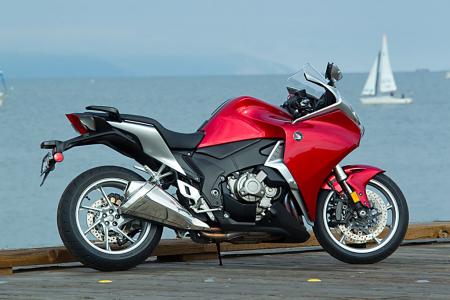 A compact dual clutch looks aesthetically pleasing and is unobtrusive. The system adds 22 lbs, including separate filter for the oil circuit that controls the two clutches and electronics. |
Conclusion
A few hundred VFR1200Fs were just recalled overseas, but Honda says this will not apply to U.S. models and maintains its optimism about its new machine.
Whether or not the dual-clutch transmission really offers performance gains for motorcycles could be shown if we raced a DCT-equipped bike against one without – or if Honda developed this transmission for a CBR.
One area where the VFR won’t perform as well is in a rider’s ability to wheelie, unless he crests a road and nails the gas just right in first gear. And if there was ever any enjoyment in controlling a motorcycle with a traditional clutch and foot shifter, that, too, is gone.
But Honda wasn’t aiming at those considerations in creating a bike that goes after the same customers and costs more than comparable BMWs. Tony Defranze, senior product planner for Honda, confirmed informally that the VFR is built to a high enough level that it could be labeled an Acura, if there were any such plans to do so.
Either way, an Acura-level owner experience is offered, and Honda has 15 carefully designed accessories to enhance the package adding up to $4,399.25 over the base price of $17,499.
When we compared the standard VFR1200F to a BMW K1300S, the Honda narrowly came out as our favorite.
As for the dual clutch-equipped VFR, we think it has great potential and look forward to more time with this latest development in motorcycle history.
It will be interesting to see also whether DCT will prove as presciently pioneering as other creations that were directed by Soichiro Honda.
At this point, it is at least certain it is brilliantly engineered and exclusive, and that is exactly what those continuing the legacy of Mr. Honda say they were shooting for.
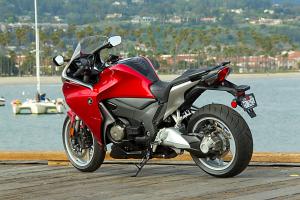
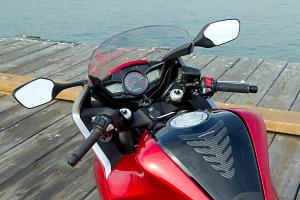
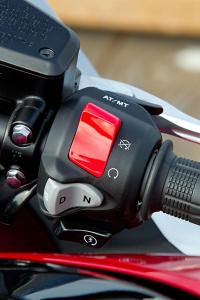
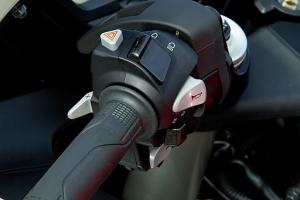
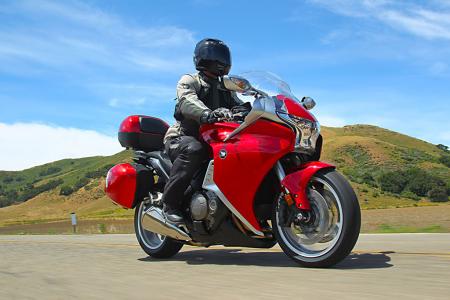

No comments:
Post a Comment